Abstracted water is used for a large number of purposes: as a domestic water supply for both consumption and for household use, for agriculture, for industry, and for many other purposes. Tidal water is also extracted for use exclusively as cooling water by electricity generating stations. The impoundment and abstraction of water is licensed by the Environment Agency under the Water Resources Act 1991. This has to be done with careful regard to environmental needs. The conditions of abstraction licences are usually framed such that water cannot be abstracted from rivers during drought conditions. Abstractors who need a constant supply of water therefore need some form of storage to retain water in wet periods for later use in dry periods. There are a number of exceptions to this general rule, relating to relatively small rates of daily abstraction for domestic and agricultural purposes, the removal of water in relation to land drainage, mining, quarrying, and related activities, and for such uses as fire-fighting.
There are, at present, about 50,000 licences for the impoundment and abstraction of water and over 10,000 hydrometric "stations" exist to measure various parameters, including surface water flow and groundwater levels.
3. The quantity of water abstracted varies from year to year (Figure 1). About half of this quantity is taken by the water companies and put into public and industrial supply and about a third is used by the electricity supply industry. Only a small proportion - less than one percent - is regularly used for spray irrigation of crops. This agricultural use occurs primarily in the Anglian and Midlands Regions, and most of the demand is concentrated over a relatively short period of some 8 to 12 weeks each year. The distribution of current abstraction licences is shown in Figure 2.
 Figure 1 Water abstractions | 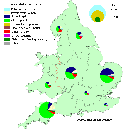 Figure 2 Abstraction licences |
The amounts put into public supply have grown steadily in recent years (Figure 3) although this trend now appears to have stabilized. Only a very small proportion of this is used as drinking water. Water is also lost via leakage in the overall distribution systems; the estimated quantities lost, and thus their percentage of the total being distributed, varies from one water company to another. The estimated values of water loss by the major regional water companies for 1994 to 1997/98 as a percentage of that put into distribution (which does not give an indication of the quantities lost) are shown in Figure 4. The Office of Water Services has set strict targets for a reduction in leakage.
 Figure 3 Public water supply | 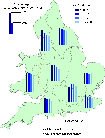 Figure 4 Total leakage |
Ground water contributes to some 30% of the overall supply of fresh water for public supply in England and Wales. The principal aquifers are shown in Figure 5. A network of observation boreholes is used to measure regularly, the levels within major aquifers. The groundwater resource is replenished by rainfall, primarily in the winter months when the amount of water lost from the surface of the ground as a result of evaporation and uptake by plants is at a minimum. Groundwater droughts are therefore caused by relatively dry winters rather than by dry summers, although the latter do, of course, contribute.
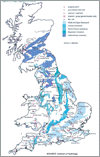 Figure 5 Major aquifers |
The relative total amounts of groundwater and surface water abstracted in 1997 are shown in Figure 6. Separately shown (Figure 7) are the quantities abstracted from each source for public supply. As can be seen, with regard to the latter, groundwater dominates in the southern regions.
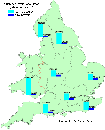 Figure 6 Quantity of abstraction | 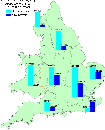 Figure 7 Public water abstraction |
In many catchments the levels of ground water and surface waters are intimately linked; ground water also serve as a water supply for surface waters, particularly chalk streams. The abstraction of water therefore has to be carefully managed. In cases of severe water shortage, water companies are entitled to impose temporary hosepipe bans. In addition, both ordinary or emergency drought orders can be made by the Secretary of State for the Environment as a result of an application either by the Agency or by a water company. The Agency also has powers to grant drought permits. The difference between drought orders and permits is that whereas both of them generally enable more water resources to be made available to the abstractor, drought orders also give the water companies powers to restrict supplies to their customers. Ordinary drought orders, and drought permits, may initially be made for a period of up to 6 months; emergency drought orders may only be made initially for a period of 3 months. The number of drought orders issued in recent years is shown in Figure 8.
 Figure 8 Drought orders |
A considerable quantity of the water abstracted in England and Wales is returned to water courses and thus re-used. Effluents from sewage treatment works and industry are therefore essential in some areas to maintain water flows in rivers and canals. This is particularly the case in the Thames catchment, where an estimated 13% of the water abstracted for public water supply has previously been abstracted, used, treated, and returned to the water courses. In some areas treated waste water effluent is used to recharge the underground chalk aquifers.
The most recent information available can be found in the National Rivers Authority's publication Saving Water 1995, the Institute of Hydrology's Hydrological Data UK, 1997 and the Environment Agency's The State of the Environment of England and Wales: Fresh Waters, 1998.